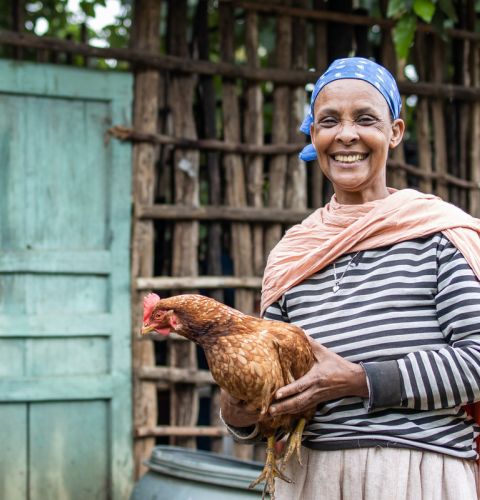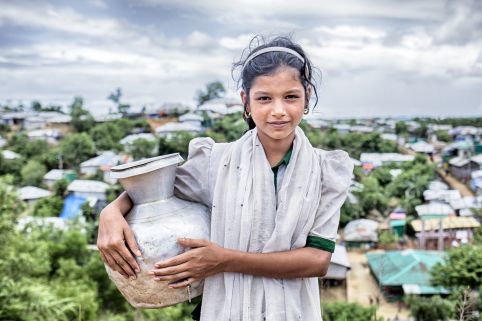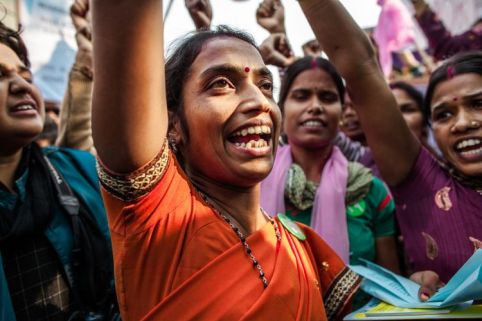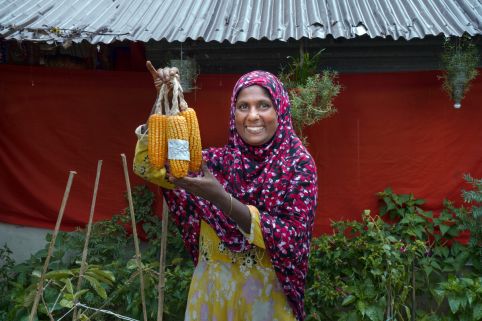We put the rights of women and girls at the heart of all we do, because the denial of women’s and girls’ rights is one of the biggest causes of poverty worldwide, and a grave injustice.
Learn more about gender equality, what ActionAid does in this area and the impact we have through our work helping adolescent girls, challenging violence against women and girls, and fighting for women's economic rights.
Why we focus on the rights of women and girls
Poverty is complex. It’s more than a lack of money. It’s also a lack of choice and power.
For women and girls, poverty means having fewer opportunities than men and boys. In the world’s poorest places this means living on the margins of society, often facing discrimination, exploitation and violence.
From the moment they’re born, many girls are seen and treated as less than boys. Girls are less likely to go to school than their brothers, and millions of girls worldwide are married as children, often to much older men.1
All over the world women and girls have less social, economic and political power, which can lead to their human rights being denied. Gender inequality is the root cause of women’s rights abuses. ActionAid supports women and girls to claim their rights.
Women’s rights are human rights
In 2015, all member states of the UN signed up to a global goal to achieve gender equality and the empowerment of all women and girls by 2030.
Because human rights apply to men and women equally, this means they can overlook women’s specific needs. So women’s rights include those that that are specific to women, or that need to be expanded to take account of women’s experiences and situations.
For instance, the use of mass rape as a weapon in war is a form of sexual violence that overwhelmingly targets women and girls, and it is now recognised as a crime against humanity within the framework of human rights.
Other fundamental women’s rights issues are violence against women and girls (VAWG), women’s economic inequality and empowerment, sexual and reproductive health and rights (SRHR) and women’s political representation.
Women’s rights are only on the international political agenda because of the tireless work of women’s rights organisations and movements fighting for change. But we still have a long way to go.
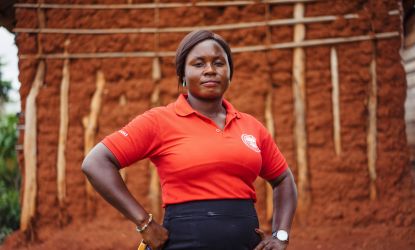
Doris Owusu Prempeh is a teacher, mother of one and a member of COMBAT, Dokyikrom, Brong Ahafo, Ghana
Nana Kofi Acquah/ActionAid
Tackling violence against women and girls in Ghana
Doris Owusu Prempeh, 30, is a teacher and a member of a Community Based Anti-Violence Team (COMBAT) in Ghana, which was established by ActionAid and local partners in 2011.
She has been an active COMBAT member for the past four years, visiting houses, churches, mosques, schools and other places to educate community members on Ghana’s domestic violence laws, broadening the knowledge of the community members on what domestic violence is and what support is available for survivors.
Doris and her COMBAT team members have also organised a campaign against early and forced marriage, and work with a young women’s group to tackle teenage pregnancy in the community.
What is discrimination against women?
There is no country in the world where women and girls as a group are not disadvantaged in relation to men and boys.
The UN Convention on the Elimination of All Forms of Discrimination against Women (CEDAW) is ‘the international bill of rights for women’. It defines discrimination against women as:
Any distinction, exclusion or restriction made on the basis of sex which has the effect or purpose of impairing or nullifying the recognition, enjoyment or exercise by women, irrespective of their marital status, on a basis of equality of men and women, of human rights and fundamental freedoms in the political, economic, social, cultural, civil or any other field.
It is important to recognise that different groups of women can be further disadvantaged, or discriminated against differently, based on other aspects of their identities. This can include race, disability, class and sexual orientation.
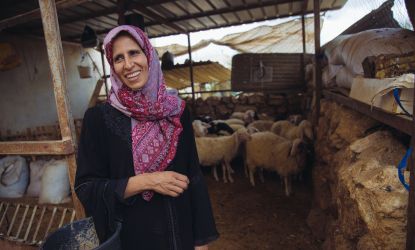
Manal, 41, in her backyard with sheep given to her by ActionAid, in the West Bank, occupied Palestinian territory.
Alice Oldenburg/ActionAid
Supporting women in the occupied Palestinian territory to generate their own income
Manal, 41, is a member of an ActionAid women's group in the occupied Palestinian territory. The group runs workshops to give women the skills and resources they need to earn their own income. Through the group, Manal has been given her own sheep so that she can support her family.
“We use the milk, we make cheese, butter. We give it to our children and sell the rest of it,” she says.
If there were no ActionAid women's group, my situation would be much worse than today. There would be no income generating for me. I hope my project will become much bigger, and that I will breed more sheep so I can earn more.
“I feel like I have earned something for myself. I have my own project and I bring my own income from it. I don’t need to ask my husband for money, I can make my own.”
What is ActionAid doing for women’s rights?
ActionAid supports and campaigns with women and girls living in some of the world’s poorest places as they challenge the root causes of poverty and injustice. Supporting women and girls as they claim their rights and lead their communities out of poverty is the most effective way of changing lives for good.6
ActionAid stands with the courageous women speaking out for change in their communities, and backs the grassroots women's rights organisations they lead. We challenge harmful societal norms which create gender inequality and allow abuses like violence against women and girls to continue.
We tackle unfair economic systems that hold women and girls back, and promote their access to justice. We ensure that local women's rights organisations are at the forefront of humanitarian response work.
What about men’s and boys’ rights?
Men and boys also experience abuses of their rights, including sexual and domestic violence. But everywhere, violence is overwhelmingly perpetrated by men against women, making it one of the most widespread abuses of human rights worldwide.
We put the rights of women and girls first, because no community can prosper together when half its citizens are denied the rights enjoyed by the other half. That is why ActionAid focuses on this issue.
Men and boys are part of the solution
To end violence against women and girls, men and boys must be involved in changing attitudes and behaviour in families and communities. And because men dominate positions of power and decision-making roles, they are important allies in the fight for women's rights.
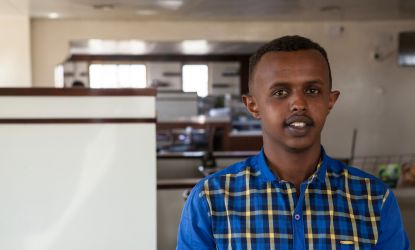
Men and boys working to end FGM
In Somaliland, ActionAid works with men and boys to change attitudes to female genital mutilation (FGM).
Ridwaan went to a training session run by ActionAid to raise awareness of the devastating impacts of FGM. He says: "The information that I am getting from the training I am sharing with people at my home - my friends, colleagues and even my family.
Of course, I am worried that people might start talking about me and that it might cause problems, but I am still determined to spread the message that FGM is bad. I am doing as much as I can, because I am worried about my fellow sisters. If I don't do anything then they are likely to suffer from FGM. So I need to spread this message so that my sisters will be safe."
Ridwaan attended a workshop about FGM in Somaliland.
Petterik Wiggers/Panos Pictures/ActionAid
Footnotes
- 1Ellsberg, M. et al. (2014) ‘Preventixon of violence against women and girls: what does the evidence say?’, The Lancet, Vol 385, No. 9977. Pp. 1555-1566. http://www.thelancet.com/journals/lancet/article/PIIS0140-6736(14)61703-7/abstract. Accessed May 2015.
- 2https://www.actionaid.org.uk/latest-news/three-in-four-women-experience-harassment-and-violence-in-uk-and-global-cities
- 3https://www.actionaid.org.uk/sites/default/files/publications/actionaid_double_jeopardy_decent_work_violence_against_women_6.pdf P.9
- 4https://www.actionaid.org.uk/latest-news/domestic-violence-kills-five-women-every-hour
- 5Ellsberg, M. et al. (2014) ‘Prevention of violence against women and girls: what does the evidence say?’, The Lancet, Vol 385, No. 9977. Pp. 1555-1566. http://www.thelancet.com/journals/lancet/article/PIIS0140-6736(14)61703-7/abstract. Accessed May 2015.
- 6https://www.actionaid.org.uk/sites/default/files/publications/actionaid_double_jeopardy_decent_work_violence_against_women_6.pdf
Page updated 5 November 2025
